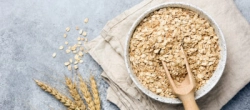Category: Grains and Cereals
Oats: Taste, Uses, and Benefits
Oats are one of the most versatile and nutritious grains, used in a variety of dishes worldwide. Their mild flavor and soft texture make them a perfect base for both sweet and savory meals. In this article, we will explore the flavor characteristics of oats, their health benefits, culinary uses, and tips on selecting and storing them.
What does Oats taste like?
Key Flavor Characteristics
Oats have a mild, slightly nutty flavor with light, grainy notes. Their taste is considered neutral, allowing them to pair well with a wide range of ingredients, both sweet and savory.
Aromatic and Textural Qualities
Oats have a subtle, grainy aroma and a soft, creamy texture when cooked. Different forms of oats – whole oat groats, steel-cut, rolled, and quick oats – have varying levels of texture and water absorption capacity.
Scientific Description of Taste and Aroma
- Aroma: Light, grainy, with a hint of sweetness.
- Taste: Slightly nutty, mild, and neutral, making it adaptable to many flavor additions.
- Texture: Creamy and soft when cooked, with slight density depending on the type of oat.

In-depth Flavor Analysis of Oats
Underlying Flavor Notes
Oats have a nuanced flavor profile that reveals subtle notes when tasted closely:
- Nutty Undertone: A mild, nutty flavor gives oats a comforting and earthy taste, which becomes more pronounced when toasted.
- Sweetness: Oats have a faint natural sweetness, especially noticeable in rolled or instant varieties, making them ideal for both sweet and savory dishes.
- Grainy Essence: The light grainy flavor adds depth, giving oats a wholesome and hearty quality that complements both fruit and spices.
Impact of Cooking Techniques on Flavor
- Raw Oats: When eaten raw, oats maintain their mild nutty flavor and firm texture, making them ideal for smoothies or toppings.
- Boiled or Steamed Oats: Cooking softens oats and brings out their creamy, slightly sweet flavor, enhancing their nutty notes and creating a soft texture.
- Toasted Oats: Toasting oats intensifies their natural sweetness and enhances the nutty and earthy flavors, adding complexity to both sweet and savory dishes.
Texture Characteristics
Oats transform in texture depending on preparation methods. Raw oats are chewy and firm, while cooked oats become creamy and soft, and toasted oats add a satisfying crunch. This flexibility in texture allows oats to be used in a range of dishes, from thick porridges to crunchy toppings.
Culinary Uses of Oats
Primary Uses
- Porridge and Breakfasts: Oats are a classic base for porridge, served with fruits, nuts, honey, or spices.
- Smoothies and Yogurts: Oats can be added to smoothies for thickness and nutrition or used as a topping for yogurt.
- Baking: Oats are a popular ingredient in cookies, breads, muffins, and other baked goods, adding a tender texture and pleasant flavor.
- Soups and Stews: Oats can be used to thicken soups and stews, adding nutritional value and creaminess.
- Oat Beverages: Oats are often used to make oat milk, a plant-based alternative to cow's milk.
Ideal Pairings for Oats
- Fruits and Berries: Apples, bananas, berries, and peaches enhance the mild taste of oats and add sweetness.
- Nuts and Seeds: Almonds, walnuts, flaxseeds, and chia seeds improve texture and add nutrients.
- Spices: Cinnamon, vanilla, nutmeg, and cardamom enrich the flavor of oats with a warm, spicy note.
- Dairy and Alternatives: Milk, yogurt, and oat milk add creaminess and softness.
- Honey and Maple Syrup: Natural sweeteners bring out the oats’ subtle sweetness, making them perfect for desserts.
Health Benefits of Oats
Key Nutrients and Benefits
- Fiber: Oats are high in soluble fiber (beta-glucans), which helps lower cholesterol and improve digestion.
- Protein: Oats are a good source of plant-based protein, supporting muscle health and overall wellness.
- Vitamins and Minerals: B vitamins, magnesium, and iron support energy and bone health.
- Antioxidants: Oats contain antioxidants, like avenanthramides, that help reduce inflammation and protect cells from damage.
Potential Precautions
- Gluten Cross-Contamination: Although naturally gluten-free, oats are often processed in facilities with wheat. Those with celiac disease or gluten sensitivity should look for certified gluten-free options.
- Excess Fiber: A high intake of oats may cause bloating or discomfort for some people, especially when there’s a sudden increase in fiber consumption.

Tips for Selecting and Storing Oats
How to Select Quality Oats
- Type of Oats: Choose based on your preferences: whole oat groats retain more nutrients, steel-cut oats offer a coarser texture, rolled oats are convenient, and quick oats provide the fastest preparation.
- Color and Smell: Oats should be light brown with a neutral, fresh aroma.
Storage Recommendations
- Dry Oats: Store in an airtight container in a dry, cool place to prevent moisture and mold.
- Cooked Oats: Store in the refrigerator in a tightly sealed container and use within 3-5 days.
Fun Facts About Oats
- Historical Use: Oats were one of the earliest grains to be cultivated in Europe and Asia.
- Skincare Benefits: Oats are used in skincare for their soothing and moisturizing properties.
- Varieties: There are several types of oats: whole groats, steel-cut, rolled, and quick oats, each with unique properties.